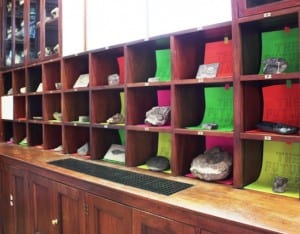The Future Took Us: Art Meets Geology
By zcwad29, on 3 August 2011
The newly relocated Grant Museum sits just across the road from the Slade, so when the banners had been strapped to the railings declaring their imminent opening back in March I was eager to get inside and see what they had done with their collection. I have always been a fan. In my first week of arriving at UCL I had visited the Grant Museum and was immediately fascinated and inspired by their collection of stuffed, jarred and pinned specimens.
So when I approached Jack Ashby at the Grant Museum with a slightly inarticulate idea for a collaboration involving the collection’s fossils, I was quite nervous and excited, for this would be an ambition realised. To my delight Jack was on board from day one.
The work that was installed was a series of 30 A3 neon posters which had been printed using the 18th century process of limestone lithographic printing with the slogan “THE FUTURE TOOK US”. A single poster was taped into each of the pigeon holes which greet you in the entrance to the museum. Upon each poster stood a fossil from the collection, creating a simple visual juxtaposition, which aimed to open a dialogue between the past and the present whilst commenting on ideas of time, materiality and permanence.
Limestone was the main impetus for this collaboration; I had become interested in the diverse use of the material and its complex relationship to ideas of monumentality and permanence. For example, the very permanence of the pyramids is threatened by the same process involved in the creation of solutional caves. It is a material which is both creative and destructive – it is transformative – and undermines our perceived ideas of permanence. Fossilisation, lithographic printing and stone carving were presented together to comment on this complex relationship. In addition the incorporation of neon paper implied an urgency, bringing the problem into a more contemporary environment and presenting a visual contrast which reflects the contrary nature of limestone.
 Close
Close



